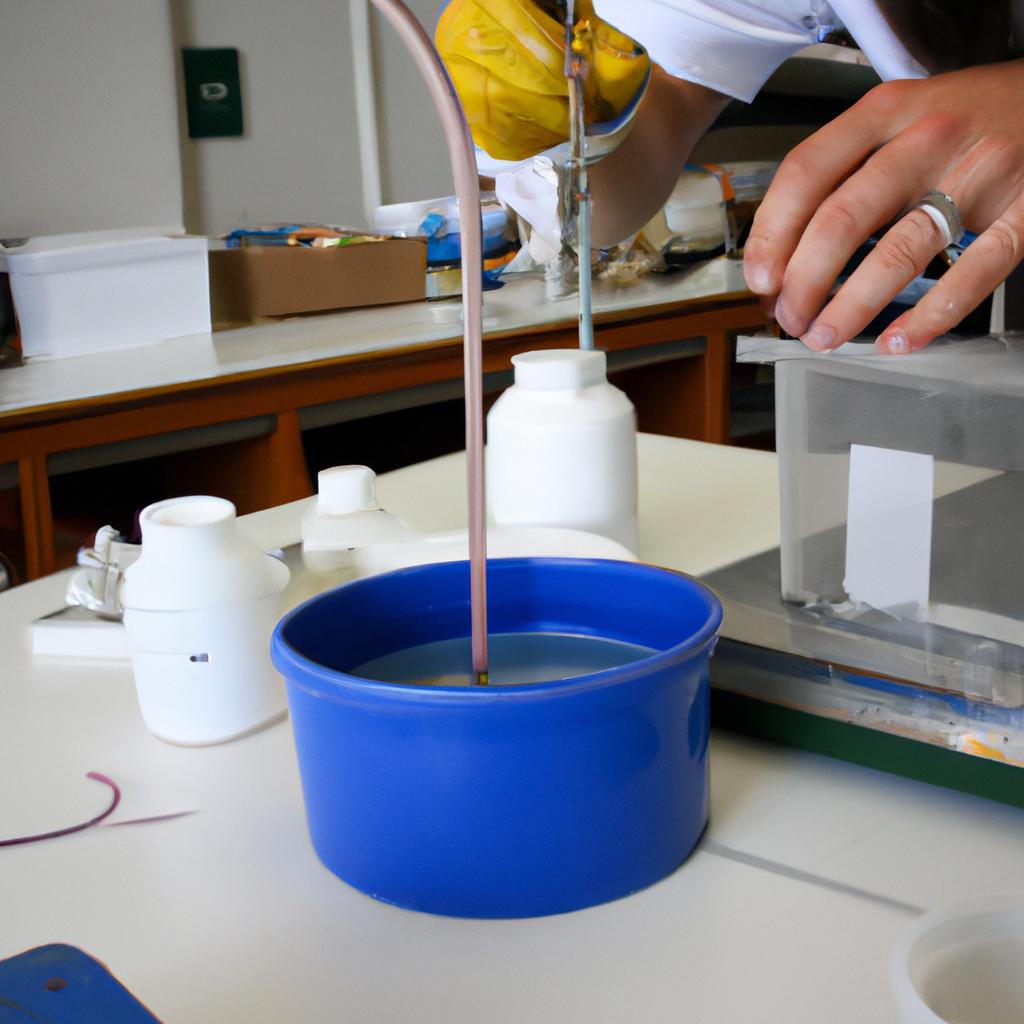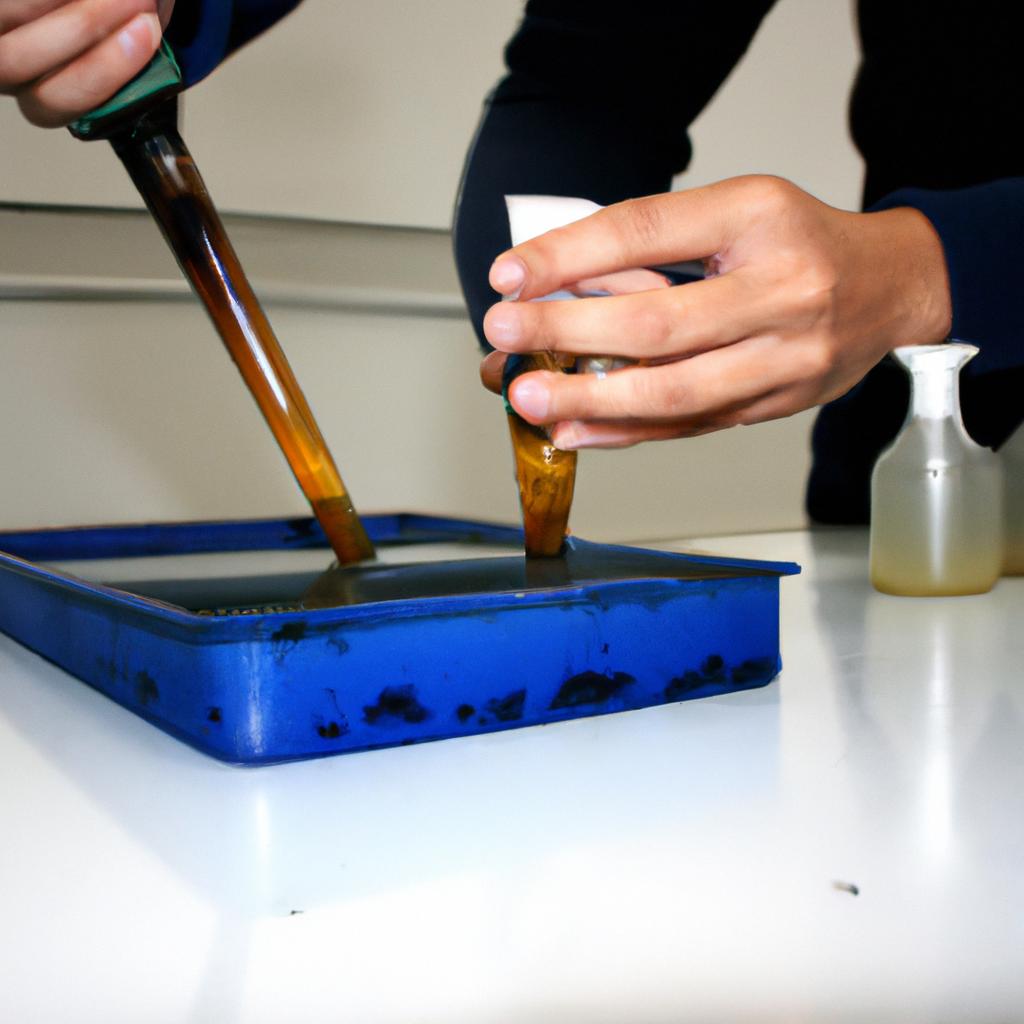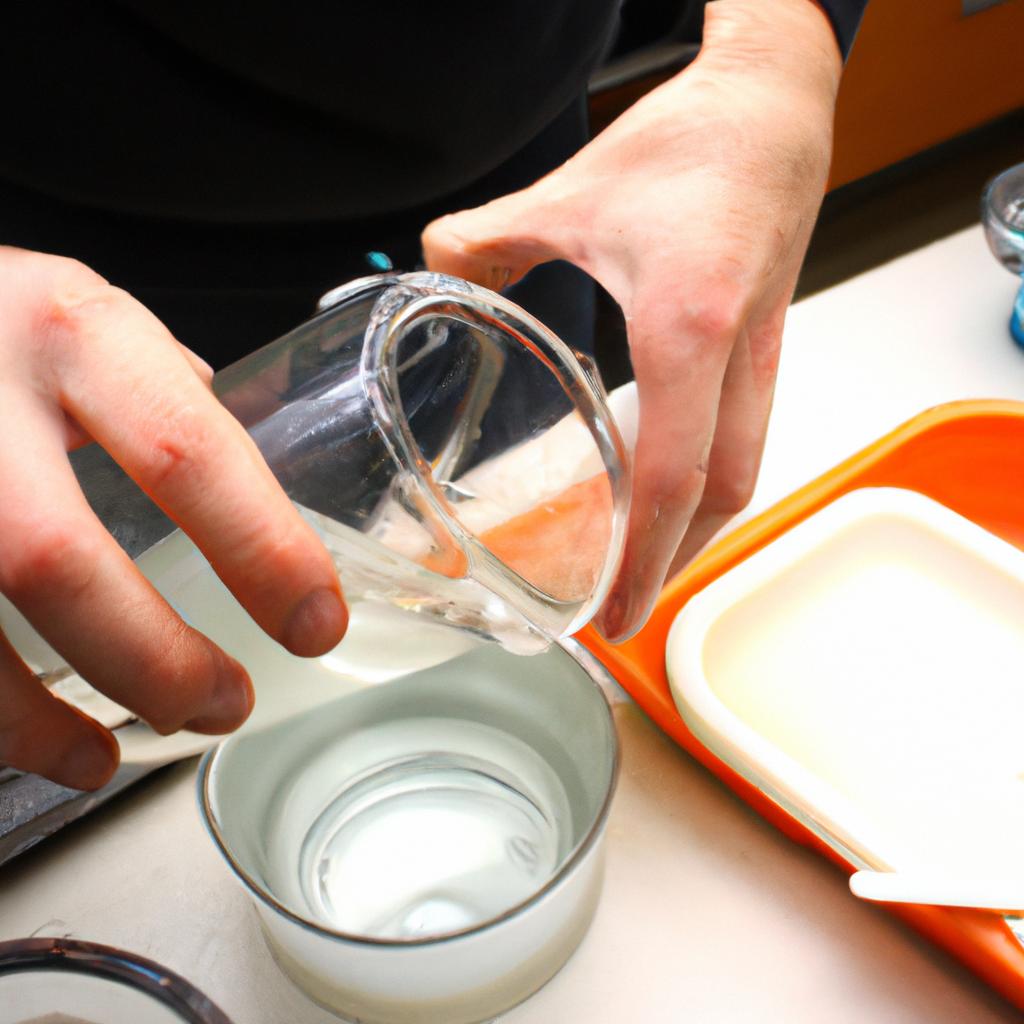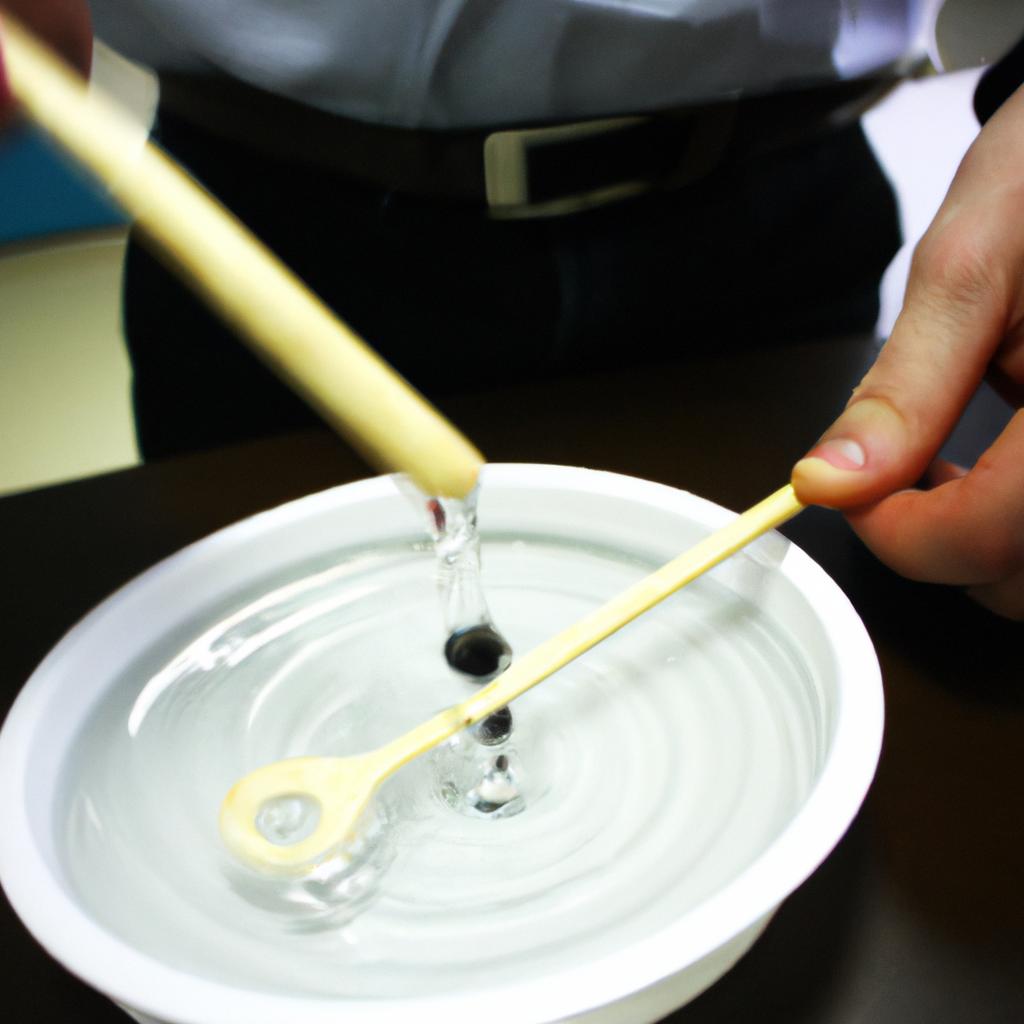Viscosity in Floating: Fluid Mechanics

Viscosity, a fundamental property of fluids, plays a crucial role in various physical phenomena. Understanding the behavior of viscous fluids is essential in fields such as fluid mechanics and engineering. This article aims to explore the concept of viscosity specifically within the context of floating objects and its implications on fluid mechanics.
Consider a hypothetical scenario where a ship floats effortlessly on water. The ability for an object to float depends not only on its weight but also on the properties of the surrounding fluid. Viscosity, defined as the resistance to flow exhibited by a fluid, influences how effectively an object can displace the surrounding medium. In this case, understanding the relationship between viscosity and floating becomes paramount in determining whether or not an object remains buoyant.
Fluid mechanics studies how forces interact with fluids at rest or in motion. Within this field, viscosity serves as a key parameter that characterizes fluid behavior and determines important aspects like drag force and flow patterns. By examining viscosity’s impact on floating objects, we gain valuable insights into how different factors affect stability and equilibrium in fluid systems. Through investigating specific cases and analyzing theoretical models, this article will delve deeper into the intricacies of viscosity in relation to floating objects—an exploration that promises to enhance our comprehension of fluid dynamics and contribute towards improved engineering designs and applications in various industries such as shipping, naval architecture, and offshore structures.
Definition of Viscosity
Imagine a container filled with honey and another containing water. If we were to place an object, such as a wooden block, in each container and observe their behavior, we would notice distinct differences. The block submerged in the water would move freely and quickly through the liquid, while the one in the honey would experience more resistance and move at a much slower pace. This variation in movement is attributed to a property known as viscosity.
Viscosity can be defined as the measure of a fluid’s internal resistance to flow or deformation when subjected to external forces. It determines how easily molecules within the fluid slide past one another, affecting its overall mobility. To better comprehend this concept, let us delve into some key points:
- Shear rate: A measure of velocity gradient between different layers of fluid that are moving parallel to each other.
- Newtonian versus non-Newtonian fluids: Newtonian fluids have constant viscosity regardless of shear rate, while non-Newtonian fluids exhibit variable viscosities under varying conditions.
- Temperature influence: Viscosity tends to decrease with increasing temperature for most liquids due to enhanced molecular motion.
- Units of measurement: Viscosity is typically measured using units like pascal-second (Pa·s) or poise (P), where 1 P equals 0.1 Pa·s.
To emphasize the significance of viscosity across various applications, consider the following table:
| Application | Importance |
|---|---|
| Lubrication | Reduces frictional wear and tear on mechanical systems |
| Coating | Ensures uniform coverage during painting or printing |
| Food processing | Determines texture and mouthfeel |
| Pharmaceutical | Controls dosage release rates |
Understanding these aspects provides valuable insights into how viscosity influences everyday phenomena encountered in fields ranging from engineering to culinary arts.
In the subsequent section, we will explore another fundamental aspect of fluid mechanics – understanding fluid dynamics. By examining the forces at play and their effects on fluids in motion, a more comprehensive comprehension of fluid behavior can be achieved.
Understanding Fluid Dynamics
Viscosity in Floating: Fluid Mechanics
Now, let us delve further into the understanding of fluid dynamics by examining how viscosity influences floating objects. To illustrate this phenomenon, consider a scenario where a wooden block is placed on the surface of water. As the block gradually sinks, one might wonder about the role that viscosity plays in determining whether an object floats or sinks.
Understanding the interaction between fluids and floating objects requires considering several key factors:
- Density differential: The density of an object compared to that of the surrounding fluid is crucial in determining buoyancy. If the density of the object is lower than that of the fluid, it will experience an upward force known as buoyant force, allowing it to float. However, if the density is higher, gravity overcomes this buoyant force, causing the object to sink.
- Surface tension: Surface tension refers to the cohesive forces at play within liquids. When an object with sufficient surface area rests on top of a liquid’s surface, these cohesive forces create an upward pull that can counteract some gravitational force acting downward.
- Viscosity: Viscosity measures a fluid’s resistance to flow. In terms of floating objects, high viscosity fluids like honey or syrup pose greater resistance against sinking due to their thicker consistency compared to low-viscosity fluids such as water.
To better understand these concepts related to viscosity and floating objects, consider Table 1 below:
Table 1: Comparison of Different Liquids’ Properties
| Liquid | Density (kg/m^3) | Surface Tension (N/m) | Viscosity (Pa*s) |
|---|---|---|---|
| Water | 1000 | 0.072 | 0.001 |
| Honey | 1400 | 0.045 | 10 |
| Vegetable Oil | 920 | 0.03 | 0.05 |
As shown in Table 1, liquids with higher density and surface tension tend to have greater resistance against sinking objects. However, it is important to note that viscosity can also play a significant role. While water has lower viscosity compared to honey or vegetable oil, the latter two are more viscous and therefore offer increased buoyancy.
Considering these factors affecting viscosity in floating, we can now proceed to explore the various elements that influence the behavior of fluids and their impact on floating objects.
[Transition sentence into the subsequent section about “Factors Affecting Viscosity in Floating”]: With an understanding of how viscosity affects floating objects, let us now delve into the factors that contribute to changes in fluid dynamics during this process.
Factors Affecting Viscosity in Floating
Transitioning from our previous discussion on understanding fluid dynamics, we now delve into the factors affecting viscosity in floating. To better comprehend this concept, let’s consider an example of a ship moving through water. The movement of the ship is influenced by various factors, including its shape and size, as well as the properties of the surrounding fluid.
Viscosity plays a crucial role in determining how easily or difficultly an object floats in a fluid. It refers to the resistance that fluids exhibit when subjected to shear stress or deformation. In simpler terms, it can be thought of as the “thickness” or “stickiness” of a liquid. Highly viscous fluids like honey flow slowly, while low-viscosity liquids such as water flow more freely.
To explore viscosity further, here are some key points worth noting:
- Viscosity varies with temperature: As temperature increases, most fluids experience a decrease in viscosity due to increased molecular motion.
- Different substances have different viscosities: For instance, comparing water and oil – water has lower viscosity compared to oil because its molecules slide past each other more easily.
- Effect of pressure on viscosity: While pressure typically does not affect viscosity significantly for gases and liquids, exceptions exist where certain materials may exhibit non-linear behavior under extreme conditions.
- Shear rate and shear stress influence viscosity: When applying force to deform a fluid layer (shear stress), the resulting velocity gradient (shear rate) affects the material’s apparent viscosity.
Let us now turn our attention to examining the relationship between viscosity and buoyancy in our subsequent section titled “Viscosity and Buoyancy Relationship.” Understanding this connection will shed light on how these two interconnected phenomena contribute to an object’s ability to float within a given fluid medium.
Viscosity and Buoyancy Relationship
In the previous section, we explored the various factors that can influence viscosity in floating. Now, let us delve deeper into the relationship between viscosity and buoyancy to gain a better understanding of this intriguing phenomenon.
To illustrate this connection, consider a hypothetical scenario where two objects with different viscosities are placed in water. Object A has low viscosity, allowing it to flow easily through the water molecules. On the other hand, object B has high viscosity, causing it to move more sluggishly through the liquid medium. As these objects float on the surface of the water, we begin to observe how their respective viscosities affect their buoyancy.
Firstly, higher viscosity tends to hinder an object’s ability to displace water efficiently. This means that for an object with high viscosity like object B, its buoyant force will be relatively weaker compared to an object with lower viscosity like object A. Consequently, if both objects have equal volumes but different viscosities, object A would experience greater upward force (buoyancy) than object B due to its superior fluid displacement characteristics.
Secondly, when considering the shape and size of floating objects, viscosity plays a crucial role. Objects with irregular shapes or larger surface areas tend to encounter greater resistance from surrounding fluids. Therefore, if two similar-sized objects have differing viscosities – one being less viscous while the other is highly viscous – the less viscous object will experience reduced drag forces and hence exhibit increased buoyancy.
Now let us reflect upon these key points:
- Higher viscosity leads to decreased fluid displacement and consequently reduces buoyant force.
- Irregular shaped or large surface area objects face greater resistance from surrounding fluids.
- Less viscous substances experience reduced drag forces and therefore demonstrate enhanced buoyancy.
- The interaction between viscosity and buoyancy influences an object’s overall stability when floating.
By examining how varying levels of viscosity impact buoyancy, we gain valuable insights into the behavior of floating objects. In the subsequent section on “Applications of Viscosity in Floating,” we will explore practical applications where this understanding can be utilized to optimize various processes and designs.
Applications of Viscosity in Floating
In the previous section, we explored the relationship between viscosity and buoyancy. Now, let us delve deeper into the applications of viscosity in floating. To illustrate this concept, consider a hypothetical scenario where an oil spill occurs in a body of water. The spilled oil forms a thin layer on the surface due to its lower density compared to water. This phenomenon can be attributed to the interplay between viscosity and buoyancy.
The influence of viscosity on floating objects is best understood through some key observations:
-
Floating behavior: Viscosity determines how easily an object can float or sink in a fluid medium. For instance, highly viscous substances like molasses have a greater resistance to flow, causing them to form thick layers that impede sinking. On the other hand, less viscous liquids such as alcohol allow for easier penetration beneath their surface.
-
Stability and equilibrium: The degree of stability achieved by a floating object depends on its shape and the surrounding liquid’s viscosity. In general, low-viscosity fluids tend to exhibit more chaotic behavior when disturbed, which may affect the overall stability of floating objects.
-
Surface tension effects: Viscosity plays a crucial role in determining surface tension—the cohesive forces present at a liquid’s interface with air or another medium. Higher viscosities lead to stronger cohesive forces, resulting in increased surface tension and potentially altering the way objects interact with the fluid’s surface.
-
Environmental impact: Understanding the implications of viscosity in floating has significant environmental relevance. When considering oil spills or chemical leaks into bodies of water, knowledge about how different substances behave can aid in containment efforts and reduce ecological damage.
- Increased understanding of viscosity aids in developing effective strategies for containing hazardous spills.
- Awareness about the interplay between buoyancy and viscosity promotes responsible management of natural resources.
- Applying principles of fluid mechanics can help mitigate the environmental impact of accidents involving substances with varying viscosities.
- Investigating viscosity in floating enhances our ability to protect aquatic ecosystems and preserve biodiversity.
Additionally, a three-column, four-row table could be used to present relevant data or comparisons related to different scenarios, such as oil spills in various environments. This visual representation can evoke an emotional response by highlighting the potential consequences of not considering viscosity’s role in floating.
In summary, understanding the applications of viscosity in floating is crucial for comprehending how objects interact with fluid mediums. By examining real-world situations like oil spills and considering factors such as stability, surface tension effects, and environmental impact, we develop valuable insights into this phenomenon. In the subsequent section on experimental techniques for measuring viscosity, we will explore practical methods that allow us to quantify these properties accurately without relying solely on theoretical considerations.
Experimental Techniques for Measuring Viscosity
Applications of Viscosity in Floating:
In the previous section, we explored various applications of viscosity in floating. Now, let us delve into the experimental techniques used to measure viscosity accurately.
Experimental Techniques for Measuring Viscosity:
To obtain precise measurements of viscosity, scientists and engineers employ several experimental techniques. One example is the rotational viscometer method, which involves rotating a spindle immersed in a fluid sample. The resistance encountered by the spindle provides insights into the fluid’s viscosity properties.
Other commonly used techniques include:
- Capillary tube method: This technique measures the time it takes for a liquid to flow through a capillary tube under gravity or pressure. By analyzing this flow rate, researchers can determine the fluid’s viscosity.
- Falling ball viscometer: Utilizing gravitational force, this approach measures how quickly a small sphere falls through a viscous liquid. The velocity of descent allows for calculations of the fluid’s viscosity.
- Oscillating disk rheometer: Employing an oscillating disk submerged in the fluid, this technique analyzes the torque required to rotate the disk at different frequencies. These measurements provide valuable information about both dynamic and shear viscosity.
These experimental techniques offer invaluable insights into viscosities and enable researchers to understand their impact on floating systems better.
| Experimental Technique | Advantages | Disadvantages |
|---|---|---|
| Rotational Viscometer | Accurate | Expensive equipment |
| Capillary Tube Method | Simple setup | Limited application range |
| Falling Ball Viscometer | Wide range of applicability | Requires careful calibration |
| Oscillating Disk Rheometer | Measures both dynamic and shear viscosity | Complex data interpretation |
By utilizing these methods collectively, researchers strive to enhance our understanding of fluids’ behavior during floating processes. Such knowledge aids in designing efficient flotation devices, optimizing material selection for buoyancy, and improving the overall performance of systems that rely on floating principles.
In summary, experimental techniques play a pivotal role in accurately measuring viscosity. The rotational viscometer method, capillary tube method, falling ball viscometer, and oscillating disk rheometer are just a few examples of the tools utilized by scientists to gain insights into fluid dynamics. Through these techniques, researchers can unlock new possibilities for innovation and advancement in various industries reliant on floating mechanisms.





